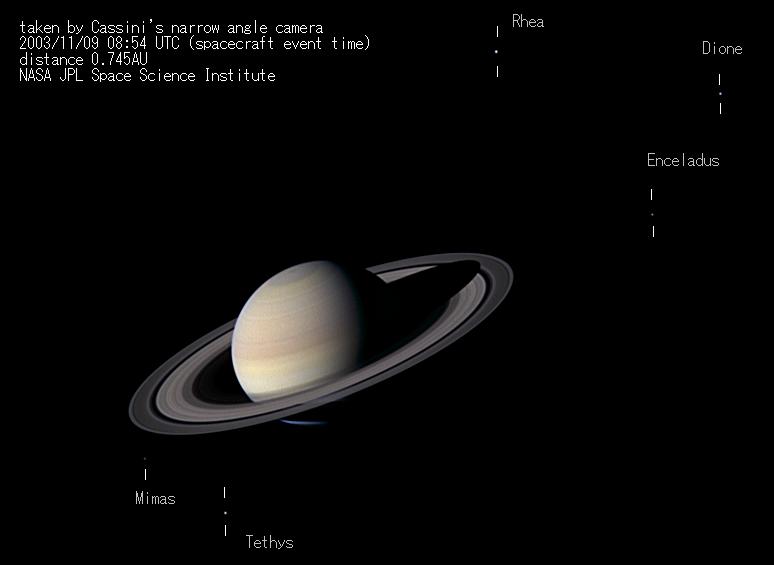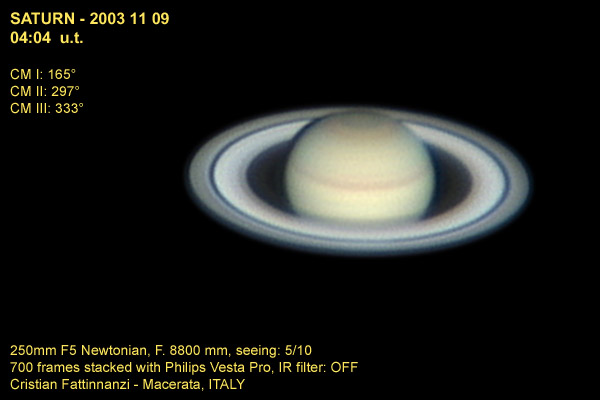|
The Cassini-Huygens mission
|
土星のカラー画像 5個の衛星がみえています。
Enhanced unshap mask by T.I.
 jpg 29kB Original size picture.1024X1024 made south UP.
tiff 3073kB 1024X1024 Original picture
撮影時刻 2003/11/09 08:54(UTC) (spacecraft event time)
カッシーニの狭角カメラによって撮影されました。距離 11140万km(0.76AU)
2002/11/01の画像よりかなり良く撮れました。リングの近くの複雑な雲パターン及び、小さな衛星の新しい特徴などが、
土星に近づくにつれて明瞭になっていきます。土星の大きなリングの詳細な様子が、既に見えています。
(略 リングの既知内容の説明)
土星の大気層、広帯域のR G Bイメージから再現されたこの画像の色は、眼視イメージに非常に近い。
太陽光のあたっている南の半球の黄色、茶色、及び、赤の微妙な色相は、木星上の色より繊細で、微かである。
木星も土星も表面の色は、白いアンモニア雲と色粒子の混合により引き起こされる。
土星表面のアンモニア雲は、木星よりで更に深く、更に厚い。
アンモニアガスが土星では更に冷たい大気層の更に深いレベルで凝縮するからである。
着色粒子の正体は、わかっていない。しかし、温帯、低緯度での主な成分は硫黄や窒素が含まれていると考えられている。
南の極付近の、黒味がかったかすみは、中緯度の茶色と比較してかなりグレーである。
この極地のかすみは、メタンガスを破壊するオーロラにおける活発な電子、及び、陽子によって作られているかもしれない
( 複合的炭化水素のかすみの形成につながって ) 。
星の北半球は、リングの影になっている ( カッシーニ空隙を通る光が本体を照らしているところだけが見えている。 )
この北半球の部分的に見えるところは、南半球より青っぽいように思われる
( おそらくかすみ、及び、雲の上のこれらの高層大気の水素による分子の散乱 )
カッシーニ探査機が今後の5年にわたり、我々にどのような観測結果をもたらすかわからないが、
季節的日照加熱が変化することにより、色彩や、他のメカニズムについての季節変化を理解する機会となるであろう。
5個の衛星が見えている。これらの像は3〜10倍に増光強調してある。
衛星は、右側最も明るいのがRhea (直径1530km) 、右端 Dione (直径1120km) 本体近い Enceladus (直径520km)
左側下 Tethys (直径1060km) 、本体近いところに、Mimas (直径392km)
1980年1981年のVoyager探査において、土星の衛星は氷のような特徴がある事がわかった。
Enceladus は、太陽系内で最も反射率が高い。
Mimas と、 Tethys の両方は、それらの表面に大きいクレータがある。
DioneとRheaは、明るいく細い不思議な筋がある。
カッシーニ探査機は Rhea Dione Enceladusを、50m以下の解像度の画像を得られるほど接近することになっている。
5 つの衛星についてはVoyager の解像度(2km)より優れた解像度の画像が、得られるであろう。
カッシーニ探査機は、 2004年7月1日に土星周回軌道にはいる予定です。
The Cassini-Huygens mission は、 NASA 、欧州宇宙機関、及び、イタリアのスペース機関の協力的なミッションである。
JPL 、パサディナのカリフォルニア工科大学の部署は、 NASA の宇宙科学事務所、ワシントン D.C. の組織である。
Credit: NASA/JPL/Space 科学協会
Released: 2003 年 12 月 5 日
tiff 3073kB 1024X1024 Original picture
jpg 29kB Original size picture.1024X1024 made south UP.
tiff 3073kB 1024X1024 Original picture
撮影時刻 2003/11/09 08:54(UTC) (spacecraft event time)
カッシーニの狭角カメラによって撮影されました。距離 11140万km(0.76AU)
2002/11/01の画像よりかなり良く撮れました。リングの近くの複雑な雲パターン及び、小さな衛星の新しい特徴などが、
土星に近づくにつれて明瞭になっていきます。土星の大きなリングの詳細な様子が、既に見えています。
(略 リングの既知内容の説明)
土星の大気層、広帯域のR G Bイメージから再現されたこの画像の色は、眼視イメージに非常に近い。
太陽光のあたっている南の半球の黄色、茶色、及び、赤の微妙な色相は、木星上の色より繊細で、微かである。
木星も土星も表面の色は、白いアンモニア雲と色粒子の混合により引き起こされる。
土星表面のアンモニア雲は、木星よりで更に深く、更に厚い。
アンモニアガスが土星では更に冷たい大気層の更に深いレベルで凝縮するからである。
着色粒子の正体は、わかっていない。しかし、温帯、低緯度での主な成分は硫黄や窒素が含まれていると考えられている。
南の極付近の、黒味がかったかすみは、中緯度の茶色と比較してかなりグレーである。
この極地のかすみは、メタンガスを破壊するオーロラにおける活発な電子、及び、陽子によって作られているかもしれない
( 複合的炭化水素のかすみの形成につながって ) 。
星の北半球は、リングの影になっている ( カッシーニ空隙を通る光が本体を照らしているところだけが見えている。 )
この北半球の部分的に見えるところは、南半球より青っぽいように思われる
( おそらくかすみ、及び、雲の上のこれらの高層大気の水素による分子の散乱 )
カッシーニ探査機が今後の5年にわたり、我々にどのような観測結果をもたらすかわからないが、
季節的日照加熱が変化することにより、色彩や、他のメカニズムについての季節変化を理解する機会となるであろう。
5個の衛星が見えている。これらの像は3〜10倍に増光強調してある。
衛星は、右側最も明るいのがRhea (直径1530km) 、右端 Dione (直径1120km) 本体近い Enceladus (直径520km)
左側下 Tethys (直径1060km) 、本体近いところに、Mimas (直径392km)
1980年1981年のVoyager探査において、土星の衛星は氷のような特徴がある事がわかった。
Enceladus は、太陽系内で最も反射率が高い。
Mimas と、 Tethys の両方は、それらの表面に大きいクレータがある。
DioneとRheaは、明るいく細い不思議な筋がある。
カッシーニ探査機は Rhea Dione Enceladusを、50m以下の解像度の画像を得られるほど接近することになっている。
5 つの衛星についてはVoyager の解像度(2km)より優れた解像度の画像が、得られるであろう。
カッシーニ探査機は、 2004年7月1日に土星周回軌道にはいる予定です。
The Cassini-Huygens mission は、 NASA 、欧州宇宙機関、及び、イタリアのスペース機関の協力的なミッションである。
JPL 、パサディナのカリフォルニア工科大学の部署は、 NASA の宇宙科学事務所、ワシントン D.C. の組織である。
Credit: NASA/JPL/Space 科学協会
Released: 2003 年 12 月 5 日
tiff 3073kB 1024X1024 Original picture
A cold, dusky Saturn looms in the distance in this striking, natural color view of the ringed planet and five of its icy satellites. This image was composed of exposures taken by Cassini's narrow angle camera on November 9, 2003 at 08:54 UTC (spacecraft event time) from a distance of 111.4 million km (69.2 million mi) -- about three-fourths the distance of the Earth from the Sun -- and 235 days from insertion into Saturn orbit. The smallest features visible here are about 668 km (415 mi) across, which is a marked improvement over the last Cassini Saturn image released on November 1, 2002. New features such as intricate cloud patterns and small moons near the rings should become visible over the next several months as the spacecraft speeds toward its destination.
Some details within Saturn's massive ring system are already visible. Structure is evident in the B ring, the middle and brightest of Saturn's three main rings. The 4800 km (2980 mi)-wide Cassini Division is the distinctive dark, central band that separates the outermost A ring from the brighter B ring. Interestingly, the outer edge of the B ring is maintained by a strong gravitational resonance with the moon Mimas, also visible in this image (see below). The 325 km (200 mi)-wide Encke gap in the A ring, near the outer edge of the ring system, is also visible, as is the fainter C ring, interior to the B ring.
With a thickness of only a few tens of meters or less, the main rings span 274,000 km (171,000 mi) from one end to the other… about three-quarters of the distance between the Earth and the Moon.
Saturn's multi-banded, multi-hued atmosphere is also apparent at this distance. In this composite made of images taken through broadband blue, green, and red spectral filters, the color is very close to what the human eye would see. The different hues of yellow, brown and red seen in the illuminated southern hemisphere are more delicate and subtle than the colors on Jupiter. Coloration on both Jupiter and Saturn is caused by small colored particles mixed with the white ammonia clouds. The ammonia clouds on Saturn are deeper and thicker than those on Jupiter because ammonia gas condenses at a deeper level in Saturn's colder atmosphere. The composition of the colored particles is not known but is thought to include sulfur and nitrogen as key constituents at middle and low latitudes.
In the southern polar region, a dusky haze is visible, more gray than the light-brown at middle latitudes. This polar haze may be produced by energetic electrons and protons in the aurorae which destroy methane gas, leading to the formation of a haze of complex hydrocarbons.
Most of Saturn's northern hemisphere is in shadow of the rings, with the exception of a small sliver visible on the limb. (Light passing through the Cassini Division illuminates the higher altitudes in the atmosphere.) This sliver appears bluer than the visible southern hemisphere, probably due to molecular scattering by hydrogen at these altitudes above the haze and clouds. As the Cassini tour unfolds over the next five years and beyond, we will have an opportunity to see how the colors change with time, whether due to changing seasonal heating or to some other mechanism.
Five Saturnian satellites can also be seen in this image. The brightnesses of these bodies have been increased three- to ten-fold to enhance visibility. The satellites are, on the left, from brightest to faintest, Rhea (1530 km, 951 mi across), Dione (1120 km, 696 mi), and Enceladus (520 km, 323 mi); and on the right, from brightest to faintest, Tethys (1060 km, 659 mi) and Mimas (392 km, 244 mi).
From the Voyager encounters in 1980 and 1981, we know that each of Saturn's icy moons possesses intriguing features. Enceladus is the most reflective body in the solar system; both Mimas and Tethys exhibit large craters on their surfaces; Dione and Rhea have curious streaks of bright, wispy material. Cassini will make very close approaches to Rhea, Dione and Enceladus, returning images in which features as small as 50 meters or less will be detectable. Images with details finer than those seen by Voyager (~ 2 km, 1.3 mi) will be returned from all five moons.
Cassini will enter Saturn orbit on July 1, 2004.
The Cassini-Huygens mission is a cooperative mission of NASA, the European Space Agency and the Italian Space Agency. JPL, a division of the California Institute of Technology in Pasadena, manages the mission for NASA's Office of Space Science, Washington, D.C.
Credit: NASA/JPL/Space Science Institute
Released: December 5, 2003
Image/Caption Information
[NASA/JPL/Space Science Institute]
 ALPO-Japan Latest ALPO-Japan Latest

 Saturn Section Saturn Section
|
 [Fattinnanzi Cristian : Macerata ITALY]
[Fattinnanzi Cristian : Macerata ITALY][Fattinnanzi Cristian : Macerata ITALY]
jpg 29kB Original size picture.1024X1024 made south UP. tiff 3073kB 1024X1024 Original picture 撮影時刻 2003/11/09 08:54(UTC) (spacecraft event time) カッシーニの狭角カメラによって撮影されました。距離 11140万km(0.76AU) 2002/11/01の画像よりかなり良く撮れました。リングの近くの複雑な雲パターン及び、小さな衛星の新しい特徴などが、 土星に近づくにつれて明瞭になっていきます。土星の大きなリングの詳細な様子が、既に見えています。 (略 リングの既知内容の説明) 土星の大気層、広帯域のR G Bイメージから再現されたこの画像の色は、眼視イメージに非常に近い。 太陽光のあたっている南の半球の黄色、茶色、及び、赤の微妙な色相は、木星上の色より繊細で、微かである。 木星も土星も表面の色は、白いアンモニア雲と色粒子の混合により引き起こされる。 土星表面のアンモニア雲は、木星よりで更に深く、更に厚い。 アンモニアガスが土星では更に冷たい大気層の更に深いレベルで凝縮するからである。 着色粒子の正体は、わかっていない。しかし、温帯、低緯度での主な成分は硫黄や窒素が含まれていると考えられている。 南の極付近の、黒味がかったかすみは、中緯度の茶色と比較してかなりグレーである。 この極地のかすみは、メタンガスを破壊するオーロラにおける活発な電子、及び、陽子によって作られているかもしれない ( 複合的炭化水素のかすみの形成につながって ) 。 星の北半球は、リングの影になっている ( カッシーニ空隙を通る光が本体を照らしているところだけが見えている。 ) この北半球の部分的に見えるところは、南半球より青っぽいように思われる ( おそらくかすみ、及び、雲の上のこれらの高層大気の水素による分子の散乱 ) カッシーニ探査機が今後の5年にわたり、我々にどのような観測結果をもたらすかわからないが、 季節的日照加熱が変化することにより、色彩や、他のメカニズムについての季節変化を理解する機会となるであろう。 5個の衛星が見えている。これらの像は3〜10倍に増光強調してある。 衛星は、右側最も明るいのがRhea (直径1530km) 、右端 Dione (直径1120km) 本体近い Enceladus (直径520km) 左側下 Tethys (直径1060km) 、本体近いところに、Mimas (直径392km) 1980年1981年のVoyager探査において、土星の衛星は氷のような特徴がある事がわかった。 Enceladus は、太陽系内で最も反射率が高い。 Mimas と、 Tethys の両方は、それらの表面に大きいクレータがある。 DioneとRheaは、明るいく細い不思議な筋がある。 カッシーニ探査機は Rhea Dione Enceladusを、50m以下の解像度の画像を得られるほど接近することになっている。 5 つの衛星についてはVoyager の解像度(2km)より優れた解像度の画像が、得られるであろう。 カッシーニ探査機は、 2004年7月1日に土星周回軌道にはいる予定です。 The Cassini-Huygens mission は、 NASA 、欧州宇宙機関、及び、イタリアのスペース機関の協力的なミッションである。 JPL 、パサディナのカリフォルニア工科大学の部署は、 NASA の宇宙科学事務所、ワシントン D.C. の組織である。 Credit: NASA/JPL/Space 科学協会 Released: 2003 年 12 月 5 日 tiff 3073kB 1024X1024 Original picture
 ALPO-Japan Latest
ALPO-Japan Latest

 Saturn Section
Saturn Section